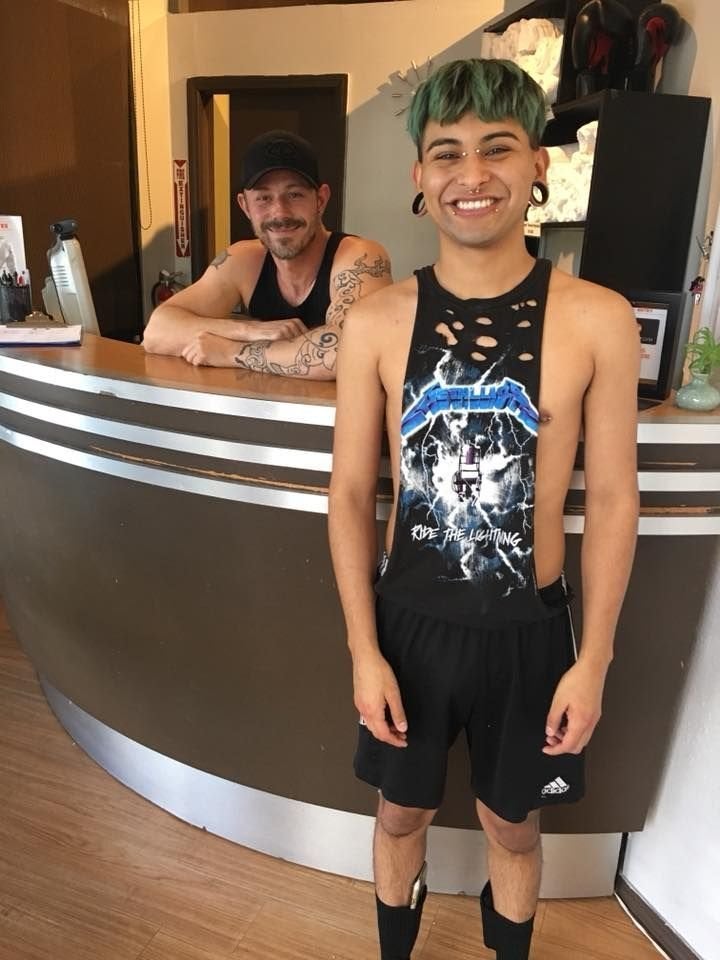
Welcome to Yahoo Lifestyle, Pride Edition, commemorating June — Pride Month — with a collection of stories celebrating the resilience of LGBTQ people, such as celebs like Adam Rippon and Munroe Bergdorf, trans women finding their inner power through a unique beauty clinic, and below, queer youth receiving vital support from their gay elders after aging out of the foster system. And so, as they shout in the streets: “We’re here, we’re queer — get used to it!”
The desert town of Palm Springs, Calif., is a well-known vacation destination and retirement hotspot, particularly for golfers and wealthy white gay men. The city boasts an exclusively LGBTQ city council and is home to some annual parties for gay men and women.
But that isn’t what brought Gary Salazar to Palm Springs. The 20-year-old from San Bernardino, Calif., had been living in a handful of different foster homes throughout his life until he aged out of the system. He wasn’t prepared to live on his own; he didn’t have resources or access. Then he found Sanctuary Palm Springs.
“Sanctuary was there for me when I was lost,” Salazar says. “Finding yourself is hard, but being yourself is harder. I struggled with the hardship of not being accepted.”
Sanctuary Palm Springs, founded by couple LD Thompson and David Rothmiller, is the first all-LGBTQ transitional housing program plus foster care residency for LGBTQ-identified youth between the ages of 18 and 21. It provides a place they can find not only a living arrangement, but also mentorship, work and education opportunities, and a safe space.
But the concept on which it is based — of older LGBTQ people who have been through similar experiences taking on the role of mentorship and surrogate parenting of LGBTQ youth in need of love and hope — is part of a slowly growing movement, as evidenced through other such support systems around the country. In Wisconsin, a gay couple is in the process of opening Courage House, set to be the state’s first group home and drop-in center specifically for LGBTQ youth; in New York City, the non-profit You Gotta Believe, which facilitates adoption for homeless youth who have come out of the foster system, launched its Pride initiative, inviting LGBTQ couples to take in LGBTQ youth; and in other states, LGBTQ adults have been stepping up to raise queer youth, recognizing that they are often the most-failed demographic in the foster system.

“By creating space that is exclusively for the LGBTQ community, you are guaranteeing that that is going to be a safe space, it’s going to be a foundation for which young people can begin to put together the other pieces of their lives that have been disrupted from being in foster care of being homeless or not having a clear path forward,” Ellen Kahn, director of the children, youth, and families program at the Human Rights Campaign (the nation’s largest LGBTQ-focused civil rights organization), tells Yahoo Lifestyle. “So it answers a problem.”
That problem, Kahn explains, is that there are still too many youth-serving organizations and services that fail when it comes to properly supporting LGBTQ youth and their unique sets of needs. “They’ve not put in inclusive policies, they’ve not trained their staff, they’ve not made clear how they will address any kind of grievances or concerns,” she says. “And so one of the things we hear repeatedly is that LGBTQ young people are often treated quite poorly when they’re in a social service system that is essentially supposed to be taking care of them, because those systems are not necessarily very affirming or supportive of LGBTQ youth.”

Sanctuary founders Thompson and Rothmiller created their new haven after moving to California from Washington, where they’d been foster care providers. While looking into options, a city CASA (Court Appointed Special Advocates) official told them the harrowing statistics about LGBTQ youth in foster care — that 100 percent of them report some kind of abuse (emotional, physical, sexual, verbal), and that they’re twice as likely to stay inside the foster system as other kids.
“By the time she was done, we were both in tears,” Thompson, who is also a filmmaker and runs a production company with his partner, recalls. “We turned to one another after this meeting and said, ‘Something really needs to be done about this.’ [She told us] ‘If you want to help LGBTQ youth and foster care, the best way you can do that is by opening a group home. There is no specific group home for kids who are identified as LGBTQ in foster care, and it is a profound need.’ So we started to investigate doing just that.”
Their hope was to open a home for youth ages 13 to 18, but California was closing group homes, making it difficult to obtain a group home license.
“We changed our plan of operation three times,” Thompson says. “Each time they kept saying, ‘No, no, no, no. Go back and change this, go back and change that,’ and they would give us a laundry list. So, crestfallen and so disappointed, we really thought, ‘OK, end of the road, we’re stopping.’”

That’s when someone suggested they opened a THP+FC — a Traditional Housing Placement Plus Foster Care facility —using an acronym then unknown to Thompson and Rothmiller that would soon become part of their everyday life. In the new home they opened in March, they are able to host six young LGBTQ Californians who came through the foster care system. (While Sanctuary’s license allows it to serve up to 11 at a time, their current home — donated by a board member who holds it in trust — can only accommodate six youths at once.)
“Currently we have a waiting list,” Thompson says. “There are three in the house who are about to graduate or move on to another circumstance, so it has been and will continue to be the sort of changing landscape.”
At Sanctuary, residents have access to counseling, skill building and educational programs, volunteering and vocational opportunities, and the ability to learn from local community leaders who serve as mentors and friends of the organization. Every month, local restaurants take turns hosting “Eat Well, Do Good” dinners, a pop-up event that donates proceeds to Sanctuary, benefitting its residents and the programming they partake in.
“Because our core competency is providing support and services and guiding and training for LGBTQ youth, this community is a phenomenal place for them to find themselves,” Thompson says. “We have a library of LGBT films and books, and our staff encourages our youth to watch these films and talk about them.”

Besides monetary donations, Palm Springs offers positive visibility for these LGBTQ youth, many of whom haven’t seen a celebration of their queer identities or the proof that it does and can get better for them.
“What they see is same-sex couples walking down the street hand in hand, unafraid, completely comfortable in their skin, able to be who they are,” Thompson says. “Our residents came to the Harvey Milk Diversity breakfast [a local Pride event], so here were 1,000 people in the morning having breakfast in Palm Springs and it was all honoring this man Harvey Milk. We had our young people there and then had them go back home afterwards to talk about and to write an essay about Harvey Milk.”
Other Palm Springs locals donate their time, volunteering to help with operations, development, and event planning for Sanctuary, looking for a way to support Thompson’s efforts. “It’s been astounding,” he says.
Thompson goes on to explain that one Sanctuary resident was concerned about finding a job because he had a criminal record. “He said, ‘Nobody’s going to hire me,’” he recalls. “And this lovely man at West Elm, who’s part of our community, he stepped up and he said, ‘Send him to me. Let me interview him.’ And he took that individual on.”
Another resident found a job at a Palm Springs barbershop.
“It’s this phenomenal synergy,” Thompson says. “Our bubble of Palm Springs is with an incredible activist-supportive and engaged community wanting for these young people to understand that they may have lost their family, but there’s a larger family for them to plug into, in the LGBT adult community.”
Thompson’s drive is partly based on his own life experience. He left home at 17 when his parents found out that he was gay.
“It was a really dark and scary time for me to be virtually on my own at 17, and to not know that I was going to be alright,” he says. “So I have that as a sort of underpinning of what I personally can provide to these young people.”
Thompson and his partner meet with the residents upon their arrival at Sanctuary, where he says they instill an important promise of safety and support.
“The message that David is fond of giving to them when they first arrive is ‘Hey, listen — you may have a basket full of problems, but one problem you don’t have anymore is the sense that you’re not OK being who you are,’” Thompson says. “And I think that that probably is the most fundamental tool that can be given — to provide them with access to resilience, is knowing that it’s OK to be you.”
Thompson says he has heard from people in other parts of the country who are interested in creating traditional housing of their own for LGBT foster youth, as well as from social workers who want to learn more about catering to the growing number of LGBT youth who end up in foster care. The success of Sanctuary has inspired him to help create diversity training in Riverside County that he hopes other counties will adapt to implement similar THP+FC programs in their own communities.
“I mean, we’re really talking about things like where you go home for Thanksgiving dinner? Who do you turn to when you have your first job interview when you want someone to talk you through or alleviate your worries and coach you on putting together a résumé? Where’s your safety net?” Kahn explains. “And so it’s unreasonable to think that youth who have already been struggling just to get any sense of permanency while in foster care are suddenly just going to be without any kind of tethering.”
At Sanctuary, Salazar says that it’s the tethering he’s found there that has allowed him to essentially start over, and to delve into his creative passions of fashion, drawing, and writing.
“They helped me find myself,” he says. “That is the greatest dream that one can hope for.”
More from Yahoo Lifestyle:
